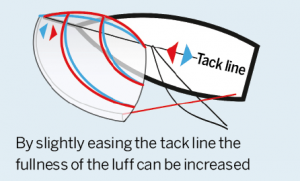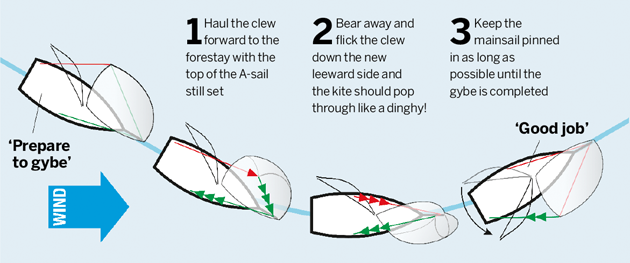Asymmetric spinnakers are allowing us to sail deeper downwind than ever. Jonty Sherwill asked sailmaker Peter Kay for his downwind tips
“Are we in on this gybe?” is often a tricky question to answer when you are far from the leeward mark with a fluctuating breeze and dirty air from behind. Not quite laying it will require a lot of work to execute a late kite drop and mark rounding. It could see you swing wide of the mark and may expose you to risk from other boats muscling in for a late overlap.
Gybing too late onto the layline wastes time and may open the door for others to round inside. Knowing your downwind angles and being able to sail deep when you need to is crucial. But there are other areas where sailing deep is important.
Asymmetric sails thrive in clear air and for sportsboat sailors in the trade-off between getting away from symmetrical spinnakers and sailing in foul tide, the latter usually wins out. But on bigger, heavier boats with purpose-designed A-sails the scenario is more evenly balanced.
Even so, A-sails will never match the S-sails when it comes to sailing deep, but the boats that can stay lower for longer will have a tactical advantage.
Although A-sails are often perceived as taking pressure off the bowman’s job, the reality is that they require a different skill set, with particular emphasis on trimming. With kites that project the luff well to windward of the forestay, maintaining good airflow is vital for sailing deep and that relies on good steering as well; steer too low and total collapse will occur, too high and vital metres of VMG are lost.
Striking the balance might seem just a matter of practice, but there are some subtle tricks to perfecting the art.
1. VMG – when to heat up
It’s important to know what you are trying to achieve, the polars for your particular boat and your target boat speeds. My issue is with those who just believe in electronics, but the VMG showing on your instruments is only as good as the accuracy of the calculations.
So make sure your instruments are well calibrated, then practise for a few weekends. Note down what works best.
2. Sheet and boat trim
When sailing deep the trimmer should ease the sheet to make the A-sail rotate around the forestay. Have some of the crew sit on the windward side to heel the boat over – the physical weight of the sail will help bring it over to windward.
Be aware that a collapse usually starts at the leeward upper corner, but you may not see that from the weather side. If you feel the sheet going light don’t pull it on hard, as that will pull the sail to leeward behind the main and possibly cause a complete collapse – telling the helmsman to head up slightly in unison with a steady trim in is a better fix.
3. Tack line
Assuming the A-sail has been purpose-designed for the boat, the length of the luff will be a bit longer than the tack point to the halyard sheave dimension to allow for the curve of the luff. In this case fully hoisted and fully hauled down should be right if the sail is being used at its designed wind speed.
However, you want the sail to address a range of wind speeds, so by slightly easing the tack line the fullness of the luff can be increased. I always ease the tack line not the halyard as the head moves around much more than the tack.
4. Minimising losses in gybes
A technique for breezy gybes that I was taught on a winning J/109 is to gybe the bottom half of the sail before you turn the boat by hauling the clew forward to the forestay with top of the A-sail still set.
You need to go into the gybe with a full sail and, by turning the boat and flicking the clew down the new leeward side, the kite should pop through like a dinghy’s. Meanwhile, keep the mainsail pinned in as long as possible until the gybe is completed.
5. Close company
Even the best lightweight running A-sail will not match a symmetrical kite for depth. My rule of thumb is that 165° true in 12 knots true breeze is the deepest you will get with an A-sail on a sprit – you might see 170° on the clock occasionally, but that will be just before your trimmer tells you to come up, or you collapse the spinnaker and you have to come up.
So if you don’t have rights, it’s best to gybe away in good time or do anything you can to maintain position if the next mark zone is getting close – see tip No 2!
Peter Kay was chief designer at North Sails UK in the 1980s and was involved in three America’s Cups. He started Parker & Kay Sailmakers in 1989, later Quantum and OneSails. He has won National titles in the Snipe and OK Dinghy, as well as European and World titles in 6-metres and Swans






